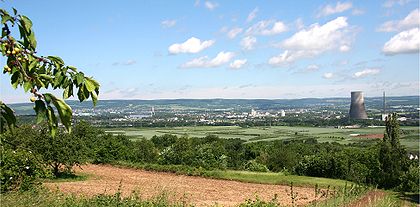New basin

The Neuwied Basin (also: Koblenz-Neuwied Basin or Neuwieder Rheintalweitung ) is a valley widening on the Rhine between the cities of Koblenz and Andernach and the center of the Middle Rhine Basin . The valley separates the narrow valley of the Upper from that of the Lower Middle Rhine over a length of about 22 kilometers . It borders on the right bank of the Rhine on the western slope of the Westerwald . On the left bank of the Rhine, its western, higher-lying parts of the landscape, the Maifeld and Pellenz , merge into the Eastern Eifel (Vordereifel).
As the only major valley widening between the Upper Rhine Plain and the Cologne Bay , which also has fertile soil, the Neuwied Basin has been settled since the earliest times. Today around 300,000 people live in the agglomeration . The seven cities of Andernach , Bendorf , Koblenz , Mülheim-Kärlich , Neuwied , Vallendar and Weißenthurm as well as a number of villages are located in a relatively small area .
The landscape of the basin is characterized by intensive fruit growing as well as by industrial settlements. Bimslagerstätten after recent outbreaks of Laacher See - volcano originated about 13,000 years ago and in the open pit can be reduced, have in the 19th century led to the development of a Bimssteinindustrie.
Natural classification
The Neuwied Basin can be assigned to the following main unit groups (two-digit code number), main units (three digits) and sub-units (decimal places) according to the manual of the natural spatial structure of Germany :
-
(to 29 - Middle Rhine area )
-
(to 291 - Middle Rhine Basin )
- 291.0 New widening of the Rhine valley
-
(to 291 - Middle Rhine Basin )
Individual evidence
- ↑ Interactive map service and description of the Rhineland-Palatinate nature conservation administration
literature
- The Middle Rhine Basin (= values of the German homeland . Volume 65). 1st edition. Böhlau, Cologne / Weimar / Vienna 2003, ISBN 978-3-412-10102-2 .
